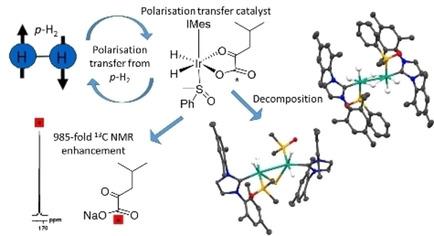当前位置:
X-MOL 学术
›
ChemPhysChem
›
论文详情
Our official English website, www.x-mol.net, welcomes your feedback! (Note: you will need to create a separate account there.)
Reversible Hyperpolarization of Ketoisocaproate Using Sulfoxide‐containing Polarization Transfer Catalysts
ChemPhysChem ( IF 2.9 ) Pub Date : 2020-11-16 , DOI: 10.1002/cphc.202000825 Ben J Tickner 1, 2, 3 , Fadi Ahwal 1, 2 , Adrian C Whitwood 2 , Simon B Duckett 1, 2
ChemPhysChem ( IF 2.9 ) Pub Date : 2020-11-16 , DOI: 10.1002/cphc.202000825 Ben J Tickner 1, 2, 3 , Fadi Ahwal 1, 2 , Adrian C Whitwood 2 , Simon B Duckett 1, 2
Affiliation

|
The substrate scope of sulfoxide‐containing magnetisation transfer catalysts is extended to hyperpolarize α‐ketoisocaproate and α‐ketoisocaproate‐1‐[13C]. This is achieved by forming [Ir(H)2(κ2‐ketoisocaproate)(N‐heterocyclic carbene)(sulfoxide)] which transfers latent magnetism from p‐H2 via the signal amplification by reversible exchange (SABRE) process. The effect of polarization transfer field on the formation of enhanced 13C magnetization is evaluated. Consequently, performing SABRE in a 0.5 μT field enabled most efficient magnetisation transfer. 13C NMR signals for α‐ketoisocaproate‐1‐[13C] in methanol‐d4 are up to 985‐fold more intense than their traditional Boltzmann derived signal intensity (0.8 % 13C polarisation). Single crystal X‐ray diffraction reveals the formation of the novel catalyst decomposition products [Ir(μ‐H)(H)2(IMes)(SO(Ph)(Me)2)]2 and [(Ir(H)2(IMes)(SO(Me)2))2(μ‐S)] when the sulfoxides methylphenylsulfoxide and dimethylsulfoxide are used respectively.
中文翻译:

使用含亚砜的极化转移催化剂实现酮异己酸酯的可逆超极化
含亚砜磁化转移催化剂的底物范围扩展到超极化α-酮异己酸酯和α-酮异己酸酯-1-[ 13 C]。这是通过形成 [Ir(H) 2 ( κ 2 -酮异己酸酯)( N -杂环卡宾)(亚砜)] 来实现的,它通过可逆交换 (SABRE) 过程的信号放大从p -H 2 转移潜磁性。评估了极化转移场对增强13 C 磁化强度形成的影响。因此,在 0.5 μT 场中执行 SABRE 可以实现最有效的磁化转移。甲醇-d 4中的α-酮异己酸酯-1-[ 13 C]的13 C NMR 信号比传统玻尔兹曼衍生的信号强度(0.8% 13 C 极化)强达 985 倍。单晶X射线衍射揭示了新型催化剂分解产物[Ir( μ ‐H)(H) 2 (IMes)(SO(Ph)(Me) 2 )] 2和[(Ir(H) 2 ( IMes)(SO(Me) 2 )) 2 ( μ ‐S)] 当分别使用亚砜甲基苯基亚砜和二甲基亚砜时。
更新日期:2021-01-07
中文翻译:

使用含亚砜的极化转移催化剂实现酮异己酸酯的可逆超极化
含亚砜磁化转移催化剂的底物范围扩展到超极化α-酮异己酸酯和α-酮异己酸酯-1-[ 13 C]。这是通过形成 [Ir(H) 2 ( κ 2 -酮异己酸酯)( N -杂环卡宾)(亚砜)] 来实现的,它通过可逆交换 (SABRE) 过程的信号放大从p -H 2 转移潜磁性。评估了极化转移场对增强13 C 磁化强度形成的影响。因此,在 0.5 μT 场中执行 SABRE 可以实现最有效的磁化转移。甲醇-d 4中的α-酮异己酸酯-1-[ 13 C]的13 C NMR 信号比传统玻尔兹曼衍生的信号强度(0.8% 13 C 极化)强达 985 倍。单晶X射线衍射揭示了新型催化剂分解产物[Ir( μ ‐H)(H) 2 (IMes)(SO(Ph)(Me) 2 )] 2和[(Ir(H) 2 ( IMes)(SO(Me) 2 )) 2 ( μ ‐S)] 当分别使用亚砜甲基苯基亚砜和二甲基亚砜时。



























 京公网安备 11010802027423号
京公网安备 11010802027423号